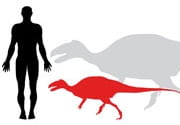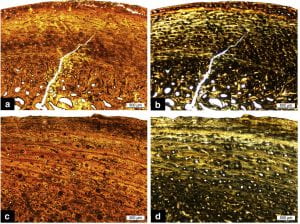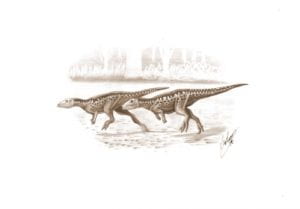| The Haţeg fauna includes two species of the genus Zalmoxes, Z. robustus which reached 3 m in length and Z. shqiperorum which was 4.0-4.5 m long. The genus name derives from the name of a freed slave of Pythagoras, who later was deified by the Dacians as a god of the underworld; modern Romania is roughly the same as Roman Dacia and the bones came from ‘the underworld’.
Zalmoxes was a herbivorous dinosaur living on Haţeg island. Unlike some other dinosaurs from Haţeg (e.g. the hadrosaur Telmatosaurus), the fossils of Zalmoxes were widespread, occurring in channel deposits and in oxidised/poorly-drained floodplain deposits (Weishampel et al. 2003). The closest relative of Zalmoxes in cladistic analysis is Rhabdodon from the Campanian and Maastrichtian of France and Spain, which together formed the Family Rhabdodontidae, sister clade to the Iguanodontia (Weishampel et al. 2003). The Iguanodontia were Early Cretaceous in age, and the Rhabdodontidae Late Cretaceous, implying a ghost lineage of 73 My between the two. The primitiveness of Zalmoxes is not unique to Haţeg island, but all the Late Cretaceous ornithopods of Europe appear to be relics, all of them having occupied islands, contrasting with the hadrosaurids seen elsewhere (Benton et al. 2010). |
Zalmoxes – dwarf dinosaur?
Figure 1: Histology of the long bones of the ornithopods Zalmoxes shqiperorum (a-b), and Z. robustus (c-d). (a-b) Long bone histology of Z. shqiperorum. The femur (length 16.4 cm) of the subadult specimen FGGUB R.1088 shows that secondary remodelling is restricted to the inner cortex indicating a late onset of remodelling. Primary osteons occur in longitudinal and reticular organization. Vascular canals open to the bone surface indicating active growth at the time of death. (b) – Same view in polarized light. (c-d) – Bone histology in the femur of Zalmoxes robustus FGGUB R.1382 (estimate of femur length 28 cm). The high number of growth marks (11; only 7 seen in this view) indicates an adult stage of this specimen. Remodelling is dense in the inner cortex and scattered in the middle cortex. (d) – Same view in polarized light.
As noted, both species of Zalmoxes are smaller than their relatives. Further, studies of bone histology show that these small individuals were largely adults, not juveniles. Samples taken from adult (Figure 1a-b) and sub-adult (Figure 1c-d) femora and humeri show a remarkable late onset of secondary remodelling, an indication of sub-adult (Figure 1c-d) and adult status (Figure 1a-b). This remodelling is restricted to the inner cortex, around blood vessels in the middle cortex and is absent in the outmost cortex. In all specimens, however, the vascular canals opening to the bone surface indicate that a fully grown state had not been reached (no external fundamental system), despite up to 13 growth rings in Z. robustus and 7 in Z. shqiperorum). Bone histology can also be used to show that at the same age Z. robustus is larger than Z. shqiperorum. Therefore bone histology shows that the small specimens were small adults rather than juveniles.
Zalmoxes is generally smaller than its close relatives, but not always. For example, Hypsilophodon from the Early Cretaceous (2.3 m long) is smaller, Thescelosaurus from the Late Cretaceous (3-4 m long) is similar in size, and others such as Camptosaurus from the Late Jurassic were larger (5-7 m long) (Benton et al. 2010). Femur lengths of Z. robustus (250-320 mm) and Z. shqiperorum (333-355 mm) are shorter than the femurs of other euornithopods, e.g. Tenontosaurus tilletti (400mm) (Forster 1990), 544 mm in the small iguanodontid Camptosaurus dispar (544 mm) (Paul 2008), and Rhabdodon priscus (600 mm) (Garcia et al. 1999).
Kindly provided by Mihai Dumbrava
Literature cited
- Benton, M.J., Csiki, Z., Grigorescu, D., Redelstorff, R., Sander, P.M., Stein, K., and Weishampel, D.B. 2010. Dinosaurs and the island rule: The dwarfed dinosaurs from Hațeg Island. Palaeogeography, Palaeoclimatology, Palaeoecology 293, 438-454. pdf.
- Forster, C.A. 1990. The postcranial skeleton of the ornithopod dinosaur Tenontosaurus tilletti. Journal of Vertebrate Paleontology 10, 273-294.
- Garcia, G., Pincemaille, M., Vianey-Liaud, M., Marandat, B., Lorenz, E., Cheylan, G., Cappetta, H., Michaux, J., and Sudre, J. 1999. Découverte du premier squelette presque complet de Rhabdodon priscus (Dinosauria, Ornithopoda) du Maastrichtien inférieur de Provence. Comptes rendus de l’Académie des Sciences de Paris 328, 415-421.
- Paul, G.S. 2008. A revised taxonomy of the iguanodontid dinosaur genera and species. Cretaceous Research 29, 192-216.
- Weishampel, D.B., Jianu, C.-M., Csiki, Z., and Norman, D.B. 2003. Osteology and phylogeny of Zalmoxes (n. g.), an unusual euornithopod dinosaur from the latest Cretaceous of Romania. Journal of Systematic Palaeontology 1, 65-123.




